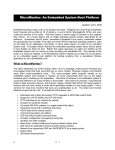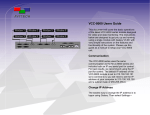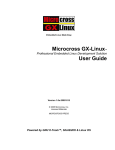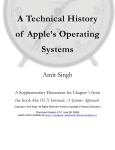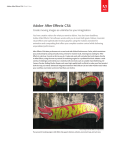Download Flash on English Flip-Book User Guide
Transcript
Flash on English Flip-Book User Guide Index 1 Introduction p. 3 2 Start up procedure 2. 1 Procedure for PC 2. 2 Procedure for MAC 2. 3 Procedure for Linux p. 4 p. 4 p. 4 p. 4 3 Creation of a profile p. 4 4 Toolbar p. 5 p. 5 p. 5 p. 5 p. 6 p. 6 p. 6 p. 6 p. 6 p. 7 p. 7 4. 1 Navigation 4. 2 Tools 4. 2 . 1 Zoom 4. 2 . 2 Paint 4. 2 . 3 Print 4. 3 Functions and extra materials 4. 3 . 1 Attachments 4. 3 . 2 Notes 4. 3 . 3 Resources 4. 3 . 4 User Guide 5 Interactive areas 5. 1 Types of interaction 5. 2 Links to course components 6 Exercises p. 8 p. 8 p. 8 6. 2 . 5 underline p. 8 p. 9 p. 10 p. 10 p. 10 p. 10 p. 11 p. 11 7 FAQ Frequently Asked Questions p. 11 8 Minimum requirements p. 12 2 Flash on English Flip-Book © ELI 2011 6. 1 Interactive exercises 6. 2 Types of exercise 6. 2 . 1 drag and drop 6. 2 . 2 write 6. 2 . 3 listen 6. 2 . 4 click User Guide Introduction 1 Introduction The Flip-Book is a programme which is full of resources and tools to be used with an Interactive Whiteboard (IWB), helping the teacher to involve the students and make the lesson more interesting and effective, but which can also be used by the student at home easily and without supervision. It contains all the contents of the Student’s Book in multimedia format and groups together all the course components in one place. The type of exercises chosen are the most suitable to be solved using the IWB or a computer. Some of them have been changed in order to offer new and more stimulating contents. This User Guide explains all the resources and tools which are available in order to use the Flip-Book and the interactive whiteboard. User Guide Flash on English Flip-Book © ELI 2011 3 Start-Up procedure - Creation of a profile 2 Start-Up procedure Starting up the Flip-Book is very easy. Here are the steps to follow: 2. 1 Procedure for PC WIN The CD will automatically start the initial screen once it has been inserted into the computer, thanks to an executable file. 2. 2 Procedure for MAC To start up in MAC, go into the CD and then double-click on the StartMac file. 2. 3 Procedure for LINUX To start the Flip-Book up in Linux, double-click on the Startlinux.html file. 3 Creation of a profile When accessing the Flip-Book, a User Name must be entered. This procedure means that the programme automatically generates a folder for the attachments and notes for that specific user. It is a good idea not to insert identical user names if there are various people using the FlipBook, so as to avoid having a single folder containing files belonging to all the users having that user name. 4 Flash on English Flip-Book © ELI 2011 User Guide Toolbar 4 Toolbar The toolbar is located on the right of the Flip-Book, but clicking on the icon , the toolbar moves from right to left. The function has been included so as to make working on the IWB easier: indeed the tools can always be used in the most convenient position for the user. 4. 1 Navigation Navigation” section contains all the tools which The “N allow you to move between the pages of the Flip-Book. Navigate by flipping through the pages two at a time. Allows you to go to the selected page by writing the page number in the space and clicking. Opens the index to the book. 4. 2 Tools Tools” section represents the heart of the Flip-Book, grouping together all the tools available to the The “T teacher for preparing the lesson. 4. 2. 1 Zoom Zoom” button enlarges any point on the page. The “Z Zoom” function and returns it to its Closes the “Z original state. Just click on the button and then on the page, dragging the tool so as to highlight the part of the page that you want to enlarge. User Guide Flash on English Flip-Book © ELI 2011 5 Toolbar 4. 2. 2 Paint Opens the palette of graphic tools which allows you to insert graphic annotations on every page of the Flipbook, write and interact with the board. With the various instruments available in the palette you can underline, circle, and highlight the shapes and in the colours that you prefer. Highlighter To highlight the words. Erase all Removes all the graphic notes on the page. Close Pen This can be used to write on the page like a real pen, underlining, circling, highlighting, drawing.... Eraser To erase a part of the drawing. The palette can also be dragged on the page as desired by clicking on the coloured part on the left. When the palette is open, the exercises and the active areas on the page are disabled. Paint” is enclosed in some of the pop up exercises, and allows you to add graphic annotations on them. “P 4. 2. 3 Print Allows you to print pages as they are or with the added graphic notes, and also lets you print the completed exercises by activating the same button in the control panel of the pop-up of the exercise itself. 4. 3 Functions and extra materials 4. 3. 1 Attachments Useful files for the lesson belonging to each user name can be kept in the folder which is automatically assigned to each user name, and which can also be retrieved and opened at any time by clicking on this button 4. 3. 2 Notes The “Notes” tool is useful for writing short notes, tips and ideas linked to the pages of the Flip-Book and its activities. The notes can easily be saved by clicking on the “Save” button and re-read every time the Flip-Book is opened. An icon, located on the left of the Flip-Book pages, gives a reminder that there is a note saved on the page. Clicking on the icon opens the saved note. 6 Flash on English Flip-Book © ELI 2011 User Guide Toolbar To create a hypertext link, insert an URL in the appropriate field, write a note and select the text from it, click on the button that creates a hypertext link and save the note. Upon retrieving the note, by clicking on the text of the note the URL link will be activated and it is then possible to view the contents. It is possible to export and import notes, by using the appropriate buttons. It is possible to remove notes once they’re no longer needed. These buttons allow you to move saved contents from one computer to another. This button allows you to remove a note. Notes and attachments are only available in the teachers’ version of the Flip-Book. 4. 3. 3 Resources The “Resources” button opens a drop-down menu via which you can access the extra contents of the course: workbook, audio-scripts, website … 4. 3. 4 User Guide Opens the full-colour User Guide as a pdf. User Guide Flash on English Flip-Book © ELI 2011 7 Interactive areas / Exercises 5 Interactive areas The Flip-Book page has several interactive areas from which the activities and multimedia resources are accessible. The interactive areas are easily recognisable because they are marked by a coloured arrow. Clicking on the area marked by the red arrow highlights the task, and opens up a balloon that tells you what type it is; by clicking on the balloon you can start the task. Clicking again on the interactive area closes the balloon. 5. 1 Types of interaction By clicking on these balloons a pop-up containing a listening activity opens up. By clicking on this balloon a pop-up containing an interactive exercise opens up 5. 2 Links to the course components By clicking on this icon a pop-up containing the pdf of the Workbook charts linked to the page. 6 Exercises By clicking on the “LListen” balloon an Audio Player opens up which allows you to listen to the audio-track, stop it, rewind or listen again to a particular point by clicking on the bar. Click and drag to move When the Audio Player is activated, the zoom tool can be used to enlarge the part of the page related to what you are listening to. It is advisable to activate the audio and then use the zoom tool on the page. The Audio Player can be freely moved about the page by clicking on the top part and dragging it. 8 Flash on English Flip-Book © ELI 2011 User Guide Exercises Zoom and listen” balloon a window By clicking on the “Z opens up containing the non-interactive activity and you can activate and control the audio via the control panel below. Start “ balloon a window opens up By clicking on the “S containing the interactive activity and various functions connected to it. 6. 1 Interactive exercises Check” button. Once the interactive exercises have been completed they can be checked by clicking on the “C The mark for the exercise cannot be checked until the exercise has been completed. The correct results are highlighted in green, the wrong ones in red. Try Again” button keeps the correct results and deletes the wrong ones to allow you to complete The “T the exercise. Start Again” button instead, you can start the exercise from the beginning. By clicking on the “S Key” button, only available in the teacher’s version, shows the exercise carried out correctly. The “K Well done!” button comes on. When the student has completed an exercise perfectly, the “W Check allows you to check the answers to the exercises carried out. It becomes Well done! when the exercise is completed perfectly Try Again keeps the correct answers and deletes the wrong ones Key shows the exercise carried out correctly (teacher’s version only) Audio Control With this the audio listening exercises can be activated, pausing and then reactivating the track, and changing the volume. In some exercises the audio can only be activated after completing the exercise, as a check-up on the answers. User Guide Flash on English Flip-Book © ELI 2011 9 Exercises Print Allows you to print the screen exactly as it appears. It can be useful if you want to print an exercise done by a student, or one with the answers, to be distributed to the whole class. Start Again Allows you to reload and then start the exercise again. Keyboard It can be used to write in the answer in fill in exercises when using the interactive whiteboard, thus avoiding having to use the board keyboard, or that of the computer. To type in the text box, without having to resort to the interactive whiteboard keyboard or that of the computer. The keypad of the Flip-Book works like a regular physical keyboard: to print the letters just click on the buttons with your mouse, or on the interactive whiteboard screen. Click and drag to move To delete, place the cursor to the right of the word to be deleted and click on the Delete button. The Keyboard can also be freely moved about the page by clicking on the top part and dragging it. The Close button above shuts down the activities and allows you to go back to the Flip-Book page. 6. 2 Types of exercises The Flip-Book contains the following types of exercise, located high on the left in the exercise pop-up and highlighted in yellow: 6. 2. 1 Drag and drop: to do this, click and drag a box with letters, words or phrases into the gaps. 6. 2. 2 Write: these are writing exercises in which you fill in the gaps, using the normal or virtual keyboard. 6. 2. 3 Listen: to play the exercises with audio, you can listen to the related audio by clicking on the “Play “ arrow before, during, or after the exercise when you want to check the answers. 10 Flash on English Flip-Book © ELI 2011 User Guide Exercises / FAQ 6. 2. 4 Click: These are true or false or multiple choice exercises where you click on the selected box (T for true and F for false). If you want to change your answer click on the box in the other column. 6. 2. 5 Underline: this is done by clicking on the correct choice – when you click the word or phoneme it will be underlined. The answers can be changed by clicking on another word or letter. For both these two types of exercises the label is the same. 10 FAQ Frequently Asked Questions 1. Is it complicated to use and install the Flip-Book? 2. What is the difference between the teacher’s version and the student’s version of the Flip-Book? 3. Can the Flip-Book work in my computer? Can it be used with the Linux operating system? 4. What do I need to do to be able to use the Flip-Book on different computers? 5. Once the Flip-Book has been installed on a computer can it be used by multiple users? 6. How can I tell if a Flip-Book page contains interactive exercises and activities? 7. What tools do I have available to prepare lessons at home with? 8. What is the difference between Notes and Attachments? 9. Are the Flip-Book exercises the same I can find in the textbook? 10. Can I find extra materials on the resources website? 1. Is it complicated to install and use the Flip-Book? The Flip-Book is very simple to use! There’s no need to be experienced at using a computer and the CD doesn’t need to be installed. The Flip-Book starts automatically after you insert the CD and to access the contents simply enter a user name. 2. What is the difference between the teacher’s version and the student’s version of the Flip-Book? The teacher’s version contains the notes and the attachments, and has the ‘answers’ button to the exercises. 3. Can the Flip-Book work in my computer? Can it be used with the Linux operating system? Yes, the Flip-Book can be used on both Windows and Mac and is usable on major Linux programmes with KDE and Gnome desktop environment, including Debian, Ubuntu, Kubuntu and Fedora. Requires web browser and updated flash plug-in. 4. What do I need to do to be able to use the Flip-Book on different computers? The Flip-Book can also be used on different computers. For example, you can take notes into class which have been saved at home by following the “Export / Import Notes” procedure and transferring the attachments via e-mail or USB stick. 5. Once the Flip-Book has been installed on a computer can it be used by multiple users? Yes, the Flip-Book is “multi-user”. At start-up different profiles can be created so that each user can access their own folder. You should not use the Flip-Book with the same user name as another user unless you want to share notes and attachments in the same folder with him/her. User Guide Flash on English Flip-Book © ELI 2011 11 FAQ / Minimun requirements 6. How can I tell if a Flip-Book page contains interactive exercises and activities? The interactive areas are easily recognisable because they are marked by a coloured arrow. On clicking the active area, a balloon opens up describing the type of activity (exercise, listening activities, video etc.). 7. What tools do I have available to prepare lessons at home with? The whole “Attachments” and “Notes “ section is specially designed to help organise your lesson at home in that it is possible to prepare PDFs, PowerPoint presentations, Word files or save comments, notes and hyperlinks for use in class. 8. What is the difference between Notes and Attachments? Attachments are personal files that help to enrich the lesson which the teacher can prepare and recall for use when desired. The Notes are quick notes or comments you may also wish to take during the lesson, or which may have a function as a memo or reminder. 9. Are the Flip-Book exercises the same I can find in the textbook? Yes, the exercises are the same, but some of them have been changed to offer new and more stimulating contents. 10.Can I find extra materials on the resources website? Of course. The site is constantly updated and open to the downloading of extra resources and audio files. 8 Minimun requirements PC / Windows / Linux Minimum Requirements Processor: Intel Pentium 4 Operating System: Microsoft 2000, XP / Vista / Seven RAM: 1 GB DVD Player (CD) Sound Card Monitor 1024x768 Recommended requirements Processor: Intel Core Duo RAM: 2 GB Monitor 1280x900 Macintosh Minimum Requirements Processor: G5 or Intel Core Duo Operating System: Mac OS X 10.4 or higher RAM: 1 GB DVD Player (CD) Sound Card Monitor 1024x768 Recommended requirements Operating System: Mac OS X 10.5 or higher RAM: 2 GB Monitor: 1280x900 12 Flash on English Flip-Book © ELI 2011 User Guide













